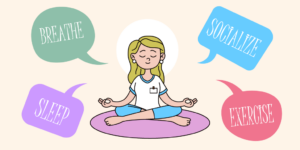We live in an age where most information can be found at our fingertips, and information on sex-ed is no exception. But as most people have learned by now, information found online isn’t necessarily accurate. While the removal of misinformation from the internet is next to impossible, one effective method in ensuring that teenagers are reliably and properly informed about all aspects of their sexual health is by mandating that comprehensive sex-ed be taught at the secondary school level all across the United States. Comprehensive sex-ed provides information about a variety of topics, from physical and biological aspects such as contraception and birth control, to the social and emotional difficulties in coming out. This strategy is known to have numerous positive effects on teenage health; schools that offer comprehensive sex-ed are shown to have lower teen pregnancy and STI rates. In other words, their students wait longer to have sex, and when they do, they are more likely to use some method of contraception.
Advisor's Note
The student writer makes reference to curriculum that is a part of Wellness classes for 9th and 10th graders. More information on Bedford High School course curriculum is available on the district web site here:
But of course, I'm not writing an Opinion article just to say that things are perfectly dandy with the sex-ed system, so allow me to introduce you to the numerous problems our sex-ed system has.
Comprehensive sex-ed is actually not even a requirement in our state, so we’re very lucky to have it at our school. In fact, less than half the United States require sex ed to be part of the health curriculum . For the remaining 26 states, they allow the schools full discretion on whether or not to teach it, and if taught, sex-ed does not have to be medically accurate. Many states then choose to pursue “abstinence-only” sex-ed, which leads to a whole host of problems.
In my home state of Delaware, for instance, sex-ed was required, but the law mandates that there is “an emphasis on abstinence-only education”, and the difference is evident. Initially, this may not really seem like a problem; abstinence is a valid option of contraception in itself, and is, one hundred percent, an acceptable choice to make for yourself. But multiple studies have shown that, contrary to the intended effect, abstinence-only education leads to higher rates of teen pregnancy and STIs, due to a lack of information about contraceptives. Abstinence-only education is driven by the idea that the only acceptable sexual practice is to have no sex at all, therefore students who don’t adopt this practice are left woefully ill-informed, and have to resort to other, less reliable means to gather information.
While we are very fortunate to be a part of a school that sees the value of sex-ed, and does not totally subscribe to the “abstinence-only” approach, there are a couple categories that we struggle in—namely consent and LGBTQ+ inclusivity. These are components of a true comprehensive sex-education program that desperately needs improvement.
An important aspect of sex-ed is consent, a subject that we are not taught until our sophomore year. I’ve often found that there is much confusion regarding the terms of consent, such as the conditions under which consent can be given, and what enthusiastic consent really is in the first place. This is troubling given that about 16% of U.S. high school students in their freshman year reported being sexually active (the term “sexually active” can be understood as having sex within the past three months). If students have not received comprehensive information regarding consent, then can we really be sure that their sex is consensual on both sides?
Another necessity for sex-ed is for it to be more inclusive of people of the LGBTQ+ community. Sex-ed, when taught, is often tailored for heterosexual couples, and rarely (if ever) mentions other genders or sexualities. A study conducted by GLSEN (the Gay, Lesbian and Straight Education Network) in 2017 revealed that just 6.7% of high school students reported receiving health classes that included positive representations of LGBTQ-related topics. This leaves the LGBTQ+ community more likely to experience negative sexual outcomes, such as higher STI rates and more cases of intimate partner violence. This puts our LGBTQ+ peers at an even greater risk of harm than they already face from discrimination towards their sexualities.
Sex-ed, while it may be a rather embarrassing topic to discuss at school, is an important aspect of human health that needs to be discussed in a safe and educational environment. That's why it is all the more important to ensure that sex-ed programs are a required component of the nation-wide education system, and that they (including ours at Bedford High School) are comprehensive enough to ensure the safety of teens around the US.






Be First to Comment